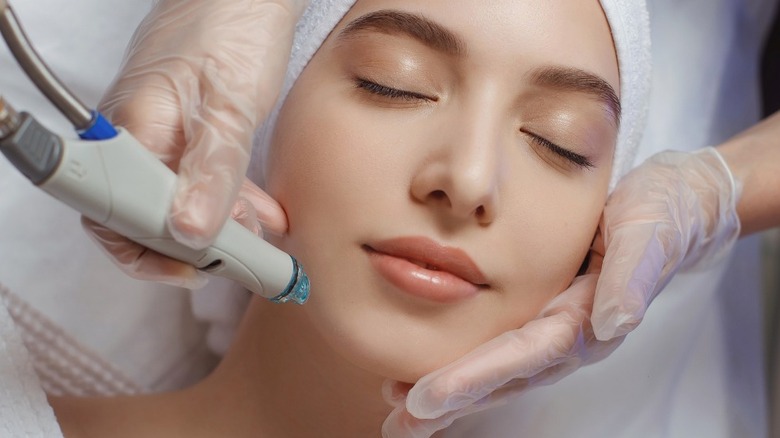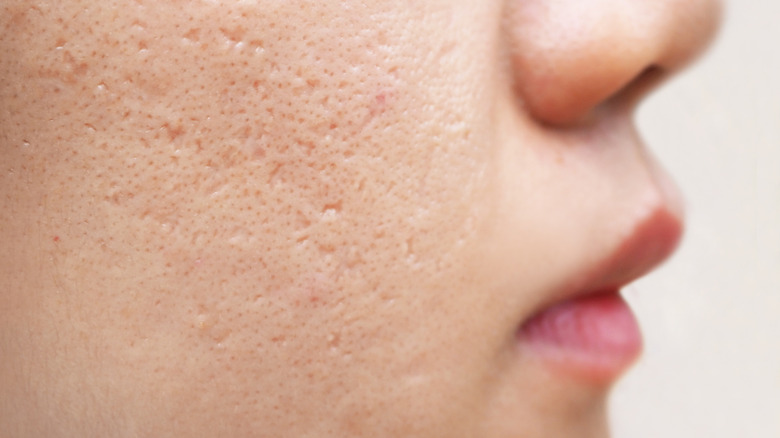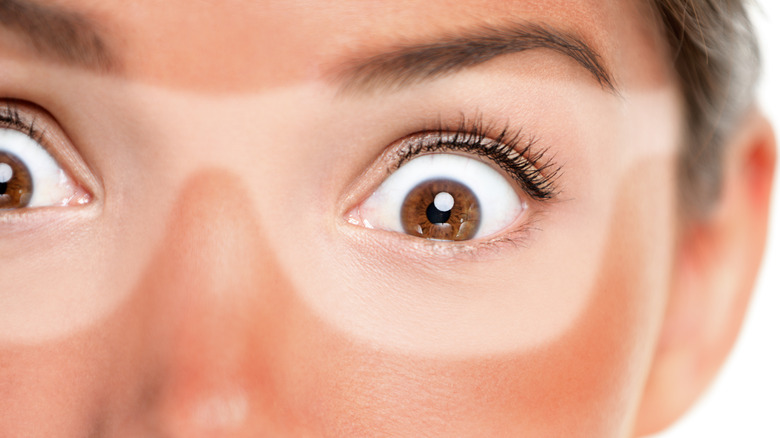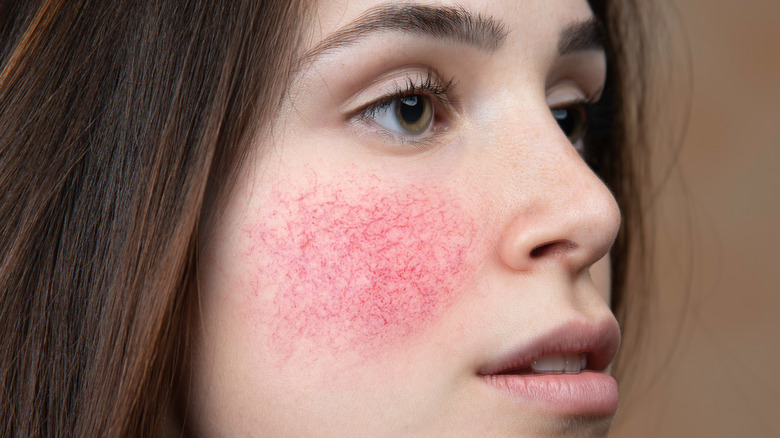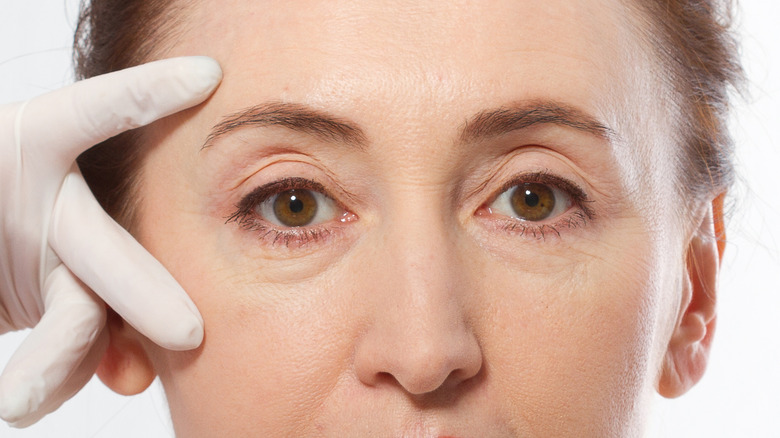What To Know Before Trying A Laser Skin Resurfacing Treatment
These days, skincare enthusiasts seem to be open to any kind of dermatological treatment that's guaranteed to reverse the aging process and leave skin looking supple, dewy, and even. That's why many dermatologists and estheticians are recommending laser treatments. According to Allure, the word "laser" stands for light amplification by stimulated emission of radiation and is considered the blanket term for any plug-in dermatologic device. Whatever your skin goals are, lasers can certainly help expedite the process.
According to New York's Icahn School of Medicine instructor Shereene Idriss, lasers work by "emitting a narrow beam of a single wavelength, or color, of light" that penetrates an area of the skin by using the ray's pulse width (via Allure). Lasers can be used to help with depigmentation, collagen growth, acne scars, redness, and even skin cancer, per Byrdie. There are two important characteristics of a laser to consider depending on your desired medical procedure: wavelength and pulse width (via Allure).
As Dr. Adam Kolker, MD, FACS, explains, "All laser light treatments target various colors within the skin to achieve their results. When the laser energy finds these targets, they super-heat them to create a very controlled 'injury' to the skin that stimulates the body's natural healing processes" (via Byrdie). With more dermatologic practices implementing these devices, they're quickly becoming the new "it" tools of skincare. So, before opting for any face-altering plastic surgeries, you may want to give one of these lasers a try.
Erase acne scars with ablative resurfacing lasers
Deep acne scars can occur when a blemish swells and breaks down inside the wall of the pore, spilling into surrounding skin tissue (via Cleveland Clinic). The skin attempts to repair the skin by producing new collagen fibers and ... voilà! You're left with a not-so-subtle reminder of your past pustules. While some acne scars are shallow and capable of self-healing, deep acne scars may need a little extra help.
That's where ablative resurfacing lasers come in. According to Schweiger Dermatology Group, these lasers combat deep acne scarring by poking tiny holes into the stratum basale, a.k.a. the deepest layer of the skin (via European Review for Medical and Pharmacological Sciences). These holes then work to regenerate collagen growth within any acne scars that have lost tissue.
However, be prepared for some moderate recovery time following this procedure. Robert Anolik, a clinical assistant professor of dermatology at the NYU School of Medicine, warns that "You'll basically look like a burn victim — swollen and scabby all over — and patients have to be psychologically ready for that" (via Allure). Luckily, both the procedure and healing process are virtually painless for patients. After about two weeks, all signs of scabs and redness should begin to fade, leaving you with that even complexion you've always dreamed of.
Fight sun damage with non-ablative laser treatments
The sun's harmful UV rays can cause a number of skin issues, such as brown spots, burns, and premature aging (via Schweiger Dermatology Group). While experts recommend battling these not-so-glamorous side effects early by wearing a daily SPF, the damage could already be done. That's why non-ablative lasers may be your best option.
Mount Sinai Medical Center dermatology instructor Anne Chapas explains the job of a laser is to "refresh and rejuvenate by building new collagen, smooth the skin, and eliminate some of the pigment that comes from sun damage" (via Allure). This is done by producing a wavelength that hits skin in a pixelated pattern. While these lasers can vary in intensity, Robert Anolik explains that they all aim to "create a vibration [rather than heat], which triggers cell signaling and the production of new collagen."
Recovery time from non-ablative laser treatments is typically short, with only an hour of redness and a week of flaky dryness.
Pulsed dye lasers can fix rosacea
Rosacea is a redness of the skin where blood vessels in the face become visible and sometimes produce pus-filled bumps (via Mayo Clinic). While symptoms come and go according to lifestyle, sufferers shouldn't have to live in fear of unwanted redness. To combat rosacea, cherry angiomas, and other red "stains," Allure recommends trying out the pulsed dye laser, or PDL.
These lasers work by heating and destroying hemoglobin, a protein in red blood cells. "The PDL's wavelength and more rapid pulse width make it helpful for diffusing background pinkness, which arises from millions of extremely tiny individual blood vessels," Robert Anolik explains (via Allure). And the best part about PDLs? Little to no recovery time.
According to Shereene Idriss, PDLs "produce pulses at the 595 nanometer (nm) wavelength, which travels through the epidermis and dermis to reach its target while sparing the surrounding tissue." Because these lasers are so targeted, there's no residual skin damage and no need to hide in your room for weeks while awaiting results.
Instead of a facelift, try a Fraxel laser
Celebrities who look like reverse-aging vampires are likely regular users of the Fraxel laser. Schweiger Dermatology Group recommends this laser for any patients who are looking to improve their complexion via firmer texture, smoother tone, or more even pigmentation. It works by shooting microscopic laser columns into the skin, spurring collagen production and replacing damaged and dead cells with new ones.
Associate clinical professor of dermatology at the Mount Sinai School of Medicine, Heidi Waldorf, especially recommends Fraxel lasers for someone "who got too much sun in her youth, but started wearing sunscreen in her 30s or 40s, as its wavelengths can correct significant, not deep, UV damage on the face, neck, chest, arms, and hands" (via Allure). Erasing UV damage is the cherry on top of this non-invasive face-lift!
The rejuvenation process of Fraxel lasers will elicit immediate results, but be prepared for minimal bronzing and flaking of the skin. Patients should appear and feel fully healed after about two weeks. Would you give this new skincare trend a try?
